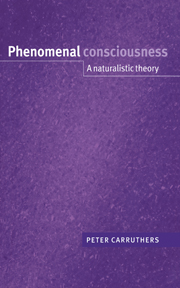Book contents
- Frontmatter
- Contents
- List of figures
- Preface
- 1 Assumptions, distinctions, and a map
- 2 Perspectival, subjective, and worldly facts
- 3 Explanatory gaps and qualia
- 4 Naturalisation and narrow content
- 5 First-order representationalism
- 6 Against first-order representationalism
- 7 Higher-order representationalism: a first defence
- 8 Dispositionalist higher-order thought theory (1): function
- 9 Dispositionalist higher-order thought theory (2): feel
- 10 Phenomenal consciousness and language
- 11 Fragmentary consciousness and the Cartesian theatre
- Conclusion
- References
- Author index
- Subject index
10 - Phenomenal consciousness and language
Published online by Cambridge University Press: 30 September 2009
- Frontmatter
- Contents
- List of figures
- Preface
- 1 Assumptions, distinctions, and a map
- 2 Perspectival, subjective, and worldly facts
- 3 Explanatory gaps and qualia
- 4 Naturalisation and narrow content
- 5 First-order representationalism
- 6 Against first-order representationalism
- 7 Higher-order representationalism: a first defence
- 8 Dispositionalist higher-order thought theory (1): function
- 9 Dispositionalist higher-order thought theory (2): feel
- 10 Phenomenal consciousness and language
- 11 Fragmentary consciousness and the Cartesian theatre
- Conclusion
- References
- Author index
- Subject index
Summary
In the present chapter I shall argue that the simple form of dispositionalist higher-order thought (HOT) theory of phenomenal consciousness defended in chapters 8 and 9 is preferable to three other similar but more elaborate accounts (put forward by Carruthers, 1996a; Dennett, 1978; and Dennett, 1991 respectively). Each of these is a form of dispositionalist HOT theory, but each makes out a constitutive connection of some sort between phenomenal consciousness and language.
Reflexive thinking theory and language
In the present section I shall contrast – favourably – the account outlined in chapter 8:3 with a rather more elaborate form of HOT theory of phenomenal consciousness, defended in some earlier publications of mine (1989b, 1992b, 1996a), which I refer to as ‘reflexive thinking theory’. But I shall suggest that it may well be that reflexive thinking theory does, de facto, describe the structure of human consciousness, as I claimed in my 1996a.
Reflexive thinking theory
According to the dispositionalist HOT theory considered in chapter 8:3, there is no requirement that the HOTs, in virtue of availability to which an experience gets to be phenomenally conscious, should themselves be conscious ones. According to reflexive thinking theory, in contrast, consciousness is constituted by an accessibility-relation to occurrent higher-order thinkings, where those thinkings are conscious in turn (that is, where they are regularly made available to further occurrent thinkings, which are, if they occur, in turn made available to yet further thinkings, and so on).
- Type
- Chapter
- Information
- Phenomenal ConsciousnessA Naturalistic Theory, pp. 271 - 296Publisher: Cambridge University PressPrint publication year: 2000



